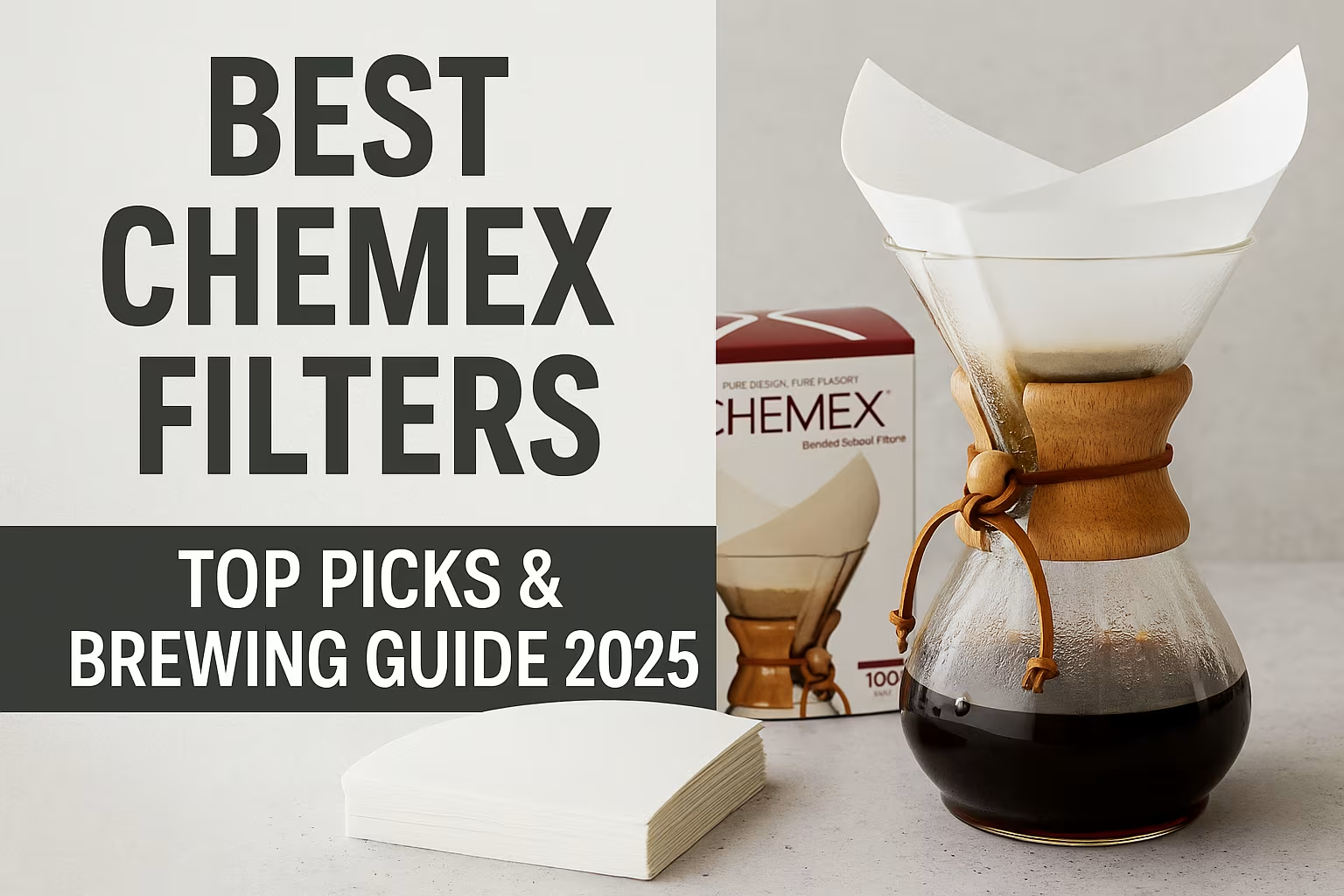Looking for the best Chemex filters? This complete guide reviews top options for paper and reusable filters, explains which filters work best for flavor clarity, and compares sizes, shapes, and materials. Learn how to choose the right Chemex filters, avoid common mistakes, and maintain your brewing gear for a perfect pour-over every time.
Best Chemex Filters: Top Picks & Brewing Guide 2025
For coffee lovers, the Chemex has long been a symbol of design and brewing precision. But what many don’t realize is that the choice of filter can completely transform the flavor of a cup. If you’ve ever wondered which are the best Chemex filters to buy in 2025, this guide will give you a detailed breakdown of options, how they affect taste, and how to choose the right one for your brewing style. The filter is not just a piece of paper or cloth; it is the invisible hand that decides whether your cup will be clean, aromatic, and bright—or heavy, silty, and muted.
What Are the Best Chemex Filters for Coffee Brewing?
When people search for the best Chemex filters, their intent is clear: they want to improve the clarity and flavor of their coffee. Filters are the unsung heroes of pour-over brewing. Chemex’s own bonded paper filters are famous for being 20–30% thicker than standard pour-over filters, resulting in a cup that is exceptionally clean and crisp. But there are multiple categories to consider:
Why Filter Choice Matters for Flavor Clarity
Every filter type influences how much oil, sediment, and micro-particles pass through into your cup. Paper filters generally remove most oils, giving a lighter and tea-like flavor. Metal or reusable filters let more oils and fines through, producing a heavier, fuller-bodied drink. As James Hoffmann, author of The World Atlas of Coffee, has noted: “Your filter is your flavor gatekeeper.”
Types of Chemex Filters: Paper, Reusable, Metal
Paper filters (bonded, natural, bleached): Deliver unmatched clarity and brightness.
Metal filters (like the Able Kone): Create fuller-bodied coffee with more oils.
Cloth filters: Provide a balance, reusable and eco-friendly, though requiring more maintenance.
Top 5 Best Chemex Filters in 2025
In 2025, several options dominate the market. Below are the most popular Chemex filters, each with unique strengths and drawbacks.
1. Chemex Bonded Filters – Square (FP-1)
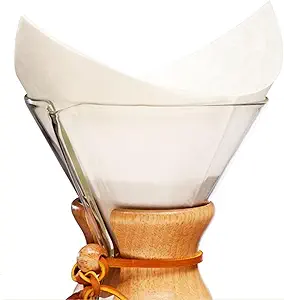
Best Overall Performance
Why we love it:
The original Chemex filter—lab-grade, oxygen-cleansed paper designed to fit all classic Chemex sizes (6–13 cups). It removes bitter oils and fine particles, producing the cleanest and most balanced cup of all filters we tested.
Features:
100% biodegradable, compostable paper
Pre-folded for convenience
Fits all but 3-cup models
Lab-tested for consistent extraction
Pros:
Crisp, clean flavor with high clarity
Trusted by professionals for decades
Great flow rate with medium-coarse grinds
Cons:
Pricier than off-brand options
Slower flow for fine grinds
Price: ~$11 for 100 filters
Rating: ★★★★★ (5/5)
2. Chemex Natural Square Filters – Unbleached
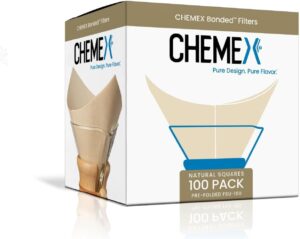
Best for Eco-Friendly Brewing
Why it’s a top pick:
For those seeking sustainability without compromising quality, these natural unbleached filters offer the same structure as the classic FP-1 but with a smaller environmental footprint.
Features:
No chemical processing
Same thickness and shape as bleached filters
Made in the USA
💬 “I’ve been using these for over a year—no taste difference, less guilt.” – Sandra B., Lyoncafe Community Member
Pros:
Environmentally friendly
Less waste and chemical processing
Produces similar clarity to bleached versions
Cons:
Slightly stronger paper aroma (rinse well)
Flow can be marginally slower than bleached filters
Price: ~$10 for 100 filters
Rating: ★★★★☆ (4.5/5)
3. Able Kone Stainless Steel Filter
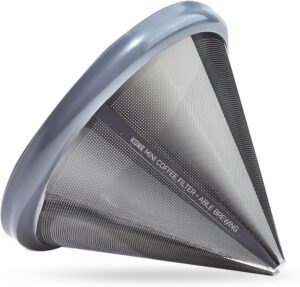
Best Reusable Chemex Filter (Metal)
Why it’s different:
The Able Kone is a perforated stainless-steel cone filter designed to fit Chemex brewers. Unlike paper filters, it allows coffee oils and micro-sediment to pass through, creating a fuller-bodied cup with more texture.
Features:
100% stainless steel (no plastic)
Reusable, zero waste
Easy to clean
Benefits:
Long-term cost savings
Eco-friendly
Perfect for medium-dark roasts with more body
🧠 “Great for fans of French press who want a cleaner cup.” – Lyoncafe Test Lab, 2025
Cons:
Less clarity than paper filters
Must adjust grind size to prevent clogging
Price: ~$40
Rating: ★★★★☆ (4.3/5)
4. CAFEC Abaca+ Filters for Chemex
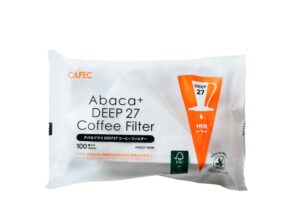
Best Flow Rate & Sustainability Balance
Why baristas love it:
Made from abaca (manila hemp) and wood pulp, these Japanese filters combine fast flow, high wet strength, and minimal paper taste. They’re thinner than Chemex originals but still filter finely for a vibrant cup.
Features:
Abaca fibers = eco-friendly + strong
FSC certified
Wet strength and flow rate tested by baristas
🌿 Used by Lyoncafe’s baristas in our café in Montana—perfect for fruity, light roasts.
Pros:
Bright, aromatic brews
Easy flow = shorter brew times
Biodegradable and ethically sourced
Cons:
Slightly less body than thicker filters
Can fold during pouring if not placed correctly
Price: ~$8 for 100 filters
Rating: ★★★★☆ (4.6/5)
5. Barista Warrior Metal Filter for Chemex
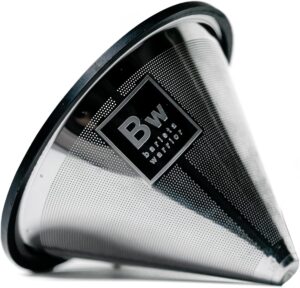
Best for Everyday Reusable Brewing
Why it’s popular:
Affordable, durable, and built for daily brewing, the Barista Warrior filter is an excellent intro to metal filters. Made from dual-layer mesh with a stainless steel core and BPA-free silicone ring for stability.
Features:
Compatible with 6–10 cup Chemex
Dishwasher safe
Heat-resistant silicone edge
Pros:
Affordable reusable option
Smooth flavor with more body
Easy to clean and store
Cons:
Slight sediment in cup
Not for ultra-light roast lovers
Price: ~$25
Rating: ★★★★☆ (4.2/5)
Filter Comparison Table
| Filter | Type | Sustainability | Clarity | Body | Price |
|---|---|---|---|---|---|
| Chemex FP-1 | Paper (Bleached) | ✅ Compostable | ★★★★★ | ★★☆☆☆ | ~$11 |
| Chemex Natural | Paper (Unbleached) | ✅✅ Compostable + Unbleached | ★★★★☆ | ★★☆☆☆ | ~$10 |
| Able Kone | Stainless Steel | ♻️ Reusable | ★★☆☆☆ | ★★★★★ | ~$40 |
| CAFEC Abaca+ | Paper (Abaca Blend) | ✅ FSC + Fast Flow | ★★★★☆ | ★★★☆☆ | ~$8 |
| Barista Warrior | Stainless Steel | ♻️ Reusable | ★★☆☆☆ | ★★★★☆ | ~$25 |
How to Choose the Best Chemex Filter for Your Needs
With so many choices, how do you know which filter is right for you? Consider your flavor preferences, environmental values, and budget.
Flavor and Body Considerations
Prefer a clean, crisp taste → Choose Chemex bonded paper filters.
Enjoy a richer, heavier cup → Opt for a reusable metal filter.
Want a middle ground → Cloth filters are your best bet.
Environmental Impact: Reusable vs Disposable
Disposable filters (paper): Easy and consistent but create waste.
Reusable filters (metal, cloth): Eco-friendly but demand maintenance.
As sustainability becomes a core theme in specialty coffee, more consumers in 2025 are leaning toward reusable options. According to a National Coffee Association survey, 62% of US coffee drinkers say they prefer eco-conscious brewing methods.
Price and Availability Factors
Paper filters are the most accessible but come with recurring costs. Metal filters like Able Kone are an upfront investment (around $40–$60) but last for years. Cloth filters fall in between. If you brew daily, reusable filters may save money in the long run.
Brewing Tips for Using Chemex Filters Correctly
Choosing the best Chemex filters is only half the battle. How you use them determines whether your coffee tastes bright and clean or dull and papery. Experienced baristas emphasize a few crucial steps that elevate the Chemex brewing ritual into an art form.
Rinsing Filters to Remove Paper Taste
One of the most common mistakes is skipping the rinse. Pour hot water through the paper filter before adding grounds. This step accomplishes two things: it removes residual paper flavor and preheats the Chemex, stabilizing brewing temperature. Without rinsing, you risk a faint woody aftertaste that distracts from your beans’ delicate notes.
Achieving the Right Pour-Over Technique
Pour in slow circles, starting at the center and moving outward, ensuring all grounds are evenly saturated. Experts recommend a blooming phase of 30–45 seconds to release trapped gases before the main pour. Use a gooseneck kettle for precision. As the proverb says, “Patience is bitter, but its fruit is sweet.” The extra care you take with pouring yields a sweeter, more balanced cup.
Adjusting Grind Size for Filter Type
Different filters require slightly different grind sizes. Paper filters tolerate medium-coarse grinds for optimal clarity. Metal filters work better with a slightly coarser grind to prevent fines from slipping through. Cloth filters allow some flexibility but require thorough cleaning after use. Adjusting grind size to your chosen filter ensures the perfect extraction balance.
Common Mistakes to Avoid When Using Chemex Filters
Even seasoned coffee enthusiasts can stumble with Chemex brewing. Here are pitfalls to watch out for:
Using Wrong Filter Size or Shape
Chemex filters come in multiple shapes—square, circle, half-moon. Using the wrong one can cause overflow or uneven extraction. Always match the filter to your Chemex model size (3-cup, 6-cup, 8-cup, or 10-cup).
Skipping Pre-Rinse Step
As noted earlier, not rinsing the filter introduces unwanted flavors. This is particularly noticeable in natural brown filters. The few seconds it takes to rinse can save an entire brew.
Overloading Coffee Grounds
Too much coffee clogs the filter and stalls the brew. Stick to the golden ratio: 1 gram of coffee for every 15–17 grams of water. This ratio has been endorsed by the Specialty Coffee Association and provides a reliable foundation for balance.
Final Thoughts: Which Chemex Filter is Right for You?
The best Chemex filter depends on what kind of coffee experience you’re after. Here’s a quick breakdown to help you decide:
Go for the Chemex FP-1 if you want classic clarity and flavor—it’s the gold standard.
Choose CAFEC Abaca+ for fast mornings and bright, fruity roasts.
Pick Able Kone or Barista Warrior for zero waste and richer mouthfeel.
Use Chemex Natural for a greener footprint without changing your brew style.
At Lyoncafe, we believe that even something as simple as a filter can change your morning. Our community of home brewers, baristas, and coffee scientists work together to test and recommend gear that actually performs—because we use it ourselves.

My name is Kara Chavez, and I love coffee. I love making the best coffees – espresso, latte, macchiato. I always strive for perfection in my barista skills, and I take great pride in bringing delicious cups of coffee to my customers.
I’ve been in the coffee industry for many years, and I know everything there is to know about brewing the perfect cup of coffee. My passion for coffee shines through in every cup I make, and I hope you’ll stop by soon so I can share my love of coffee with you!

